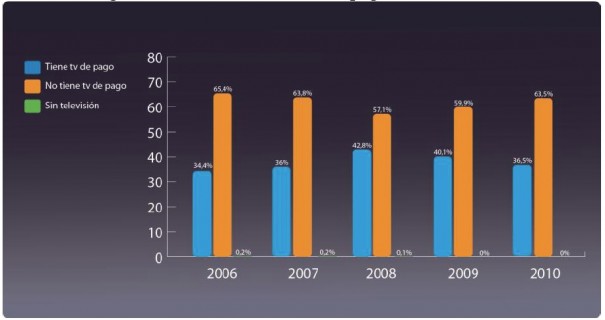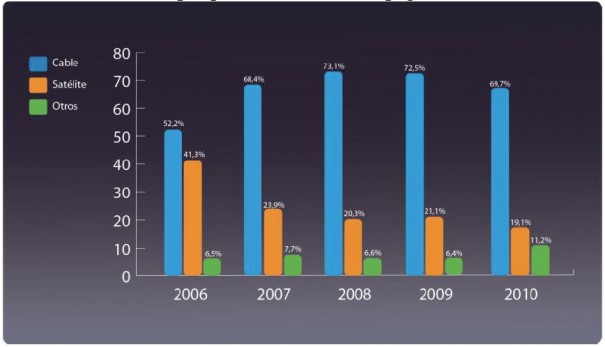La sombra TDT sobre la tv de pago en Murcia no es alargada
Isabel Sarabia Andúgar, profesora del área de Comunicación Audiovisual de la Facultad de Ciencias Sociales y de la Comunicación de la UCAM y miembro del grupo de Investigación (DIGITALAC) hace un repaso en esta Tribuna a la televisión de pago en la Región de Murcia.
La televisión de pago constituye una modalidad de consumo muy arraigada entre los ciudadanos de la Región de Murcia. La predisposición de las familias a contratar este servicio remonta a mediados de los años 80, un momento en el que la televisión por cable empieza a extenderse por iniciativa de los operadores históricos. Una década más tarde, en 1995, la implantación de este modelo de acceso a la televisión era una realidad en 34 de los 45 municipios de la comunidad autónoma. Desde entonces, la presencia de la oferta de pago, concretamente de televisión por cable, ha ido creciendo.
En este contexto cabría preguntarse si la transición a la televisión digital terrestre en la Región de Murcia ha afectado al mercado de la televisión de pago (cable, satélite, IP), y en qué medida lo ha hecho.
Los datos que se presentan en este artículo proceden del “Estudio del conocimiento, percepción y penetración de la TDT en la Región de Murcia (2006-2010)”, una investigación longitudinal realizada por el Grupo DIGITALAC de la Universidad Católica de Murcia , y financiada por la Administración regional. A modo de barómetro, a lo largo de cinco ediciones, se ha medido tanto el ritmo de implantación de la TDT como el modo en el que se ha adoptado por parte de las familias murcianas. En la ejecución de la investigación se ha empleado una metodología cuantitativa, basada en la técnica del sondeo cuya muestra (1.111 individuos) probabilística estratificada por municipios, sexo y edad, ha sido tomada a partir del universo de personas residentes en la Región de Murcia mayores de14 años. El error muestral es del +-3% y el nivel de confianza del 95.5%.
Esta investigación arranca en junio de 2006 coincidiendo con el lanzamiento de la primera señal de televisión digital terrestre de ámbito regional en la Comunidad murciana. En ese momento, en el que la TDT se encuentra en los albores de su implantación, la oferta de televisión de pago está integrada por la aportación de operadores de diferentes plataformas. El mercado de televisión por cable está ocupado, de un lado por ONO, y de otro, por los cableoperadores históricos asociados en AOTEC. El de televisión por satélite tiene un único operador, Digital+. Y en lo que se refiere a la televisión IP, en esa fecha sólo existe la oferta de Imagenio, presentada en la Región en mayo de 2005, pero pronto se suman a ella otras como Jazztelia y OrangeTV.
- Presencia de la televisión de pago en los hogares de la Región de Murcia (2006-2010)
En la primera oleada del estudio (junio 2006), el nivel de penetración de la televisión de pago es próximo al 35% de los hogares de la Región de Murcia. Curiosamente y pese a la introducción de la TDT, ese porcentaje ha ido incrementándose a lo largo de los cinco años siguientes. En 2007 sólo crece un punto porcentual, mientras que en 2008 la proporción de hogares abonados a alguna de las plataformas de televisión disponibles en la Región alcanza la cifra record de 42.8%. En la oleada siguiente, la de 2009, la cifra se sitúa en el 40.1%, para, finalmente en 2010 una vez asumido el apagón analógico, mantenerse en el 36.5%.
Hogares dotados de televisión de pago
 Fuente: elaboración propia (Digitalac) Base: 1.111 entrevistas
Fuente: elaboración propia (Digitalac) Base: 1.111 entrevistas
- Evolución de las plataformas de televisión de pago (2006-2010)
En lo que respecta a las plataformas de televisión contratadas, los datos evidencian unos cambios drásticos en las preferencias de los ciudadanos, que afectan al reparto de abonados en el mercado de la televisión de pago en la Región de Murcia. En 2006, del total de hogares dotados de servicio de televisión de pago, más de la mitad (el 52,2%) tiene contratada la oferta de cable, mientras que el 41,3% ha elegido la plataforma de satélite. Un año más tarde las cifras dan un giro contundente. Digital + pierde casi 20 puntos porcentuales que se proyectan sobre la opción del cable, que alcanza así el 68,4% de los hogares que cuentan con algún servicio de acceso condicional.
El trasvase de abonados sigue la tendencia, y en 2008 se observa que el 73.1% de los hogares abonados a alguna plataforma se ha inclinado por el cable. El año 2009 discurre en términos muy similares – el 72.5% de usuarios de televisión de pago opta por el cable, mientras que el 21.1% lo hace por el satélite-. En todos estos años desde 2006 a 2009, la televisión IP no ha conseguido penetrar en los hogares con acceso a canales de pago. La presencia de esa modalidad de tv sólo se hace visible en 2010, cuando por primera vez la Tv IP supera el 10% de las familias conectadas a la televisión de pago. Ese año, el del apagón analógico, se recogen unos datos alarmantes para la plataforma de televisión por satélite. El porcentaje de abonados es inferior a 20%. Sólo un 19.1% de las familias que tienen contratado un paquete de canales de pago se había decidido por Digital +. El resto, casi el 70% (69.7%) lo había hecho por el cable.
Abonados por plataformas de tv de pago
 Fuente: elaboración propia (Digitalac) Base: hogares dotados de tv pago
Fuente: elaboración propia (Digitalac) Base: hogares dotados de tv pago
A modo de conclusión, cabe observar que, aunque inicialmente se podía sospechar que, por su oferta multicanal y calidad, la TDT estaría en disposición de desplazar a la televisión de pago, a la vista de los datos obtenidos en el estudio longitudinal, se constata que este servicio no sólo se ha mantenido en los hogares de la Región de Murcia hasta el apagón analógico, sino que incluso durante un periodo de dos años ha captado nuevos abonados. Curiosamente el bienio 2008/2009 en el que la televisión de pago alcanza las mayores cotas de penetración en los hogares murcianos, coincide con los años en los que se intensifican las campañas informativas de Impulsa TDT y en los que los operadores también lanzan las promociones de sus nuevos canales digitales.
Una de las razones que pueden explicar este comportamiento se detecta en los datos relacionados con la percepción hacia la TDT manifestada por los ciudadanos, así como el nivel de satisfacción que ofrece. A lo largo de los cinco años, aunque más de la mitad de los murcianos han mostrado un sentimiento positivo hacia la TDT, la indiferencia sin embargo ha marcado la actitud de un amplio colectivo. Asimismo el grado de satisfacción ha sido moderado ya que los ciudadanos han presentado reservas sobre la tecnología y la calidad e interés en la oferta de canales.
En lo que se refiere a la evolución de las preferencias sobre la plataforma de televisión de pago entre la población de la Región, si se analiza con detenimiento cuáles pueden ser las razones del importante incremento de la contratación de la televisión por cable frente a otras opciones, observamos que la elección se debe, de un lado a la oferta de un canal de televisión local en los paquetes distribuidos por los operadores históricos (en localidades del centro y norte de la Región) y, de otro, por el incremento de los servicios prestados, ampliados a la telefonía fija y al acceso a Internet tanto por Ono como por los asociados a AOTEC.
En definitiva, se puede afirmar que la TDT no ha eclipsado, por lo tanto, a la televisión de pago en el periodo de transición digital sino que, por el contrario, el mercado de canales de acceso condicional ha quedado incluso reforzado.
Isabel Sarabia Andújar
profesora del área de Comunicación Audiovisual de la Facultad de Ciencias Sociales y de la Comunicación de la UCAM y miembro del grupo de Investigación (DIGITALAC)
Did you like this article?
Subscribe to our NEWSLETTER and you won't miss anything.






